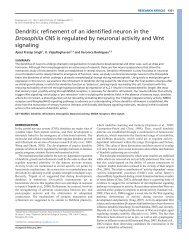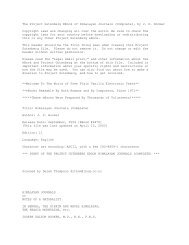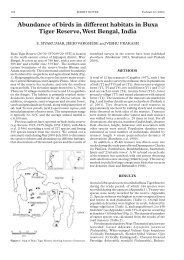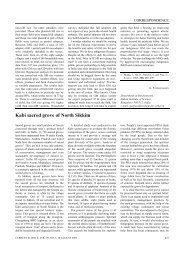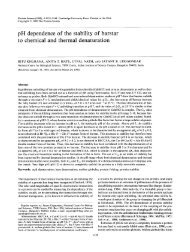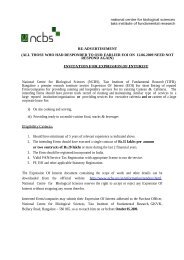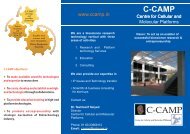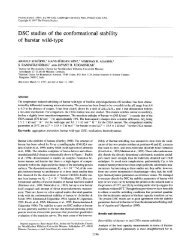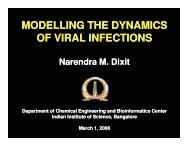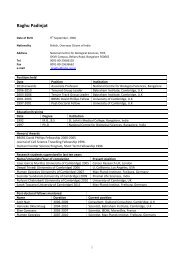Muscles in the Drosophila second thoracic segment are patterned ...
Muscles in the Drosophila second thoracic segment are patterned ...
Muscles in the Drosophila second thoracic segment are patterned ...
You also want an ePaper? Increase the reach of your titles
YUMPU automatically turns print PDFs into web optimized ePapers that Google loves.
Research Paper Homeotic gene function <strong>in</strong> <strong>Drosophila</strong> <strong>thoracic</strong> muscle development Roy et al. 227<br />
<strong>segment</strong>, or if <strong>the</strong> effectiveness with which <strong>the</strong> HT3 ectoderm<br />
is transformed towards <strong>the</strong> T2 phenotype were<br />
<strong>in</strong>creased, <strong>the</strong>reby ‘overpower<strong>in</strong>g’ Antp function <strong>in</strong> <strong>the</strong><br />
HT3 mesoderm. The <strong>second</strong> possibility may expla<strong>in</strong> <strong>the</strong><br />
presence of IFM-like muscles, albeit at a very low frequency,<br />
<strong>in</strong> <strong>the</strong> HT3 of animals that <strong>are</strong> abx, bx 3 , pbx <strong>in</strong> trans<br />
with a deficiency for <strong>the</strong> entire BX-C [22].<br />
Materials and methods<br />
Fly stocks<br />
Canton-S stra<strong>in</strong> was used as <strong>the</strong> wild-type stock <strong>in</strong> all control experiments<br />
unless o<strong>the</strong>rwise mentioned. The UAS-Antp transgenic stra<strong>in</strong> was generously<br />
provided by Sean Carroll (University of Wiscons<strong>in</strong>, Madison). The<br />
SG29.1 GAL4 l<strong>in</strong>e was generated <strong>in</strong> our laboratory by mobilization of a<br />
pGAL4 element onto <strong>the</strong> scalloped locus. The UAS-lacZ and 24B-GAL4<br />
l<strong>in</strong>es were obta<strong>in</strong>ed from Andrea Brand and Norbert Perrimon (Harvard<br />
Medical School, Boston, USA). The Antp w10 mutant stock was obta<strong>in</strong>ed<br />
from <strong>the</strong> <strong>Drosophila</strong> Stock Centre, Bloom<strong>in</strong>gton, USA. Four-w<strong>in</strong>ged flies<br />
that <strong>are</strong> homozygous for abx, bx 3 , pbx mutations <strong>in</strong> <strong>the</strong> Ubx gene were<br />
generated as described previously [7]. The e22c-GAL4 stra<strong>in</strong> was<br />
obta<strong>in</strong>ed from <strong>the</strong> <strong>Drosophila</strong> Stock Centre, Bloom<strong>in</strong>gton, USA, and it<br />
expresses GAL4 specifically <strong>in</strong> <strong>the</strong> ectoderm dur<strong>in</strong>g embryogenesis [11].<br />
We exam<strong>in</strong>ed its ability to drive Antp expression us<strong>in</strong>g <strong>the</strong> UAS-Antp<br />
transgene and Antp-specific antibodies and found that it could promote<br />
uniform levels of Antp expression all over <strong>the</strong> embryonic ectoderm.<br />
Mesodermal mosaic for Antp<br />
In order to remove Antp specifically from <strong>the</strong> mesoderm and analyze its<br />
effect on T2 muscle development, we collected embryos from a cross<br />
of male flies of <strong>the</strong> genotype e22c-GAL4/ + ; Antp w10/+ with females of<br />
<strong>the</strong> genotype UAS-Antp; Antp w10/+ . We were able to identify unambiguously<br />
embryos that were homozygous for <strong>the</strong> Antp w10 mutation on<br />
<strong>the</strong> basis of midgut morphology (Fig. 2e,f) and <strong>the</strong>se embryos were<br />
analyzed for rescue of T2 muscle pattern by sta<strong>in</strong><strong>in</strong>g with a rabbit antifly<br />
muscle myos<strong>in</strong> antibody (n = 25). Approximately half of <strong>the</strong>se<br />
embryos (n = 11/25) showed rescue of muscle pattern <strong>in</strong> both<br />
hemi<strong>segment</strong>s of T2 because <strong>the</strong>y had one copy of <strong>the</strong> e22c-GAL4<br />
and one copy of <strong>the</strong> UAS-Antp transgenes.<br />
Histochemical sta<strong>in</strong><strong>in</strong>g for -galactosidase activity<br />
-galactosidase activity from <strong>the</strong> UAS-lacZ transgene was assayed by<br />
standard procedures [15].<br />
Immunohistochemistry and microscopy<br />
Embryos, larval imag<strong>in</strong>al discs and pupal tissue were prep<strong>are</strong>d for<br />
immunohistochemistry as described previously [5,7]. The anti-Antp<br />
monoclonal antibody was a gift from Danny Brower (University of<br />
Arizona, Tucson) and was used at a dilution of 1:50. The rabbit anti-fly<br />
muscle myos<strong>in</strong> antibody, for <strong>the</strong> detection of embryonic muscle patterns,<br />
was used at a dilution of 1:500 and was obta<strong>in</strong>ed from Dan<br />
Kiehart (Duke University, Durham). Fluorophore-conjugated appropriate<br />
<strong>second</strong>ary antibodies were purchased from Jackson Immuno Research<br />
Laboratory Inc. The Vectasta<strong>in</strong> Elite Kit (Vector Laboratories) was used<br />
for <strong>in</strong>direct immunoperoxidase assays. After immunolabell<strong>in</strong>g, <strong>the</strong><br />
preparations were analyzed by laser scann<strong>in</strong>g confocal or differential<br />
<strong>in</strong>terference contrast microscopy.<br />
Analysis of IFM morphology<br />
Adult hemithoraces were dehydrated through alcohol grades, cle<strong>are</strong>d <strong>in</strong><br />
methyl salicylate, mounted <strong>in</strong> Canada Balsam and <strong>the</strong> morphology of <strong>the</strong><br />
IFMs was visualized us<strong>in</strong>g polarized light optics.<br />
Acknowledgements<br />
We thank A.H. Brand, N. Perrimon, S.B. Carroll and T. Kaufman for fly stocks;<br />
D. Brower, D. Kiehart and R. White for antibodies; K. White for use of confocal<br />
microscope and V. Rodrigues and anonymous reviewers for comments on<br />
<strong>the</strong> manuscript. This work was supported by grants from <strong>the</strong> National Centre<br />
for Biological Sciences and from <strong>the</strong> Department of Science and Technology,<br />
Govt. of India.<br />
References<br />
1. Mart<strong>in</strong>ez Arias A: Development and pattern<strong>in</strong>g of <strong>the</strong> larval<br />
epidermis of <strong>Drosophila</strong>. In The Development of <strong>Drosophila</strong><br />
melanogaster Vol. 1. Edited by Bate M, Mart<strong>in</strong>ez Arias A. New York:<br />
Cold Spr<strong>in</strong>g Harbor Laboratory Press; 1993:517–608.<br />
2. Bate M: The mesoderm and its derivatives. In The Development of<br />
<strong>Drosophila</strong> melanogaster Vol. 2. Edited by Bate M, Mart<strong>in</strong>ez Arias A.<br />
New York: Cold Spr<strong>in</strong>g Harbor Laboratory Press; 1993:1013–1090.<br />
3. Hooper J: Homeotic gene expression <strong>in</strong> muscles of <strong>Drosophila</strong><br />
larvae. EMBO J 1986, 5:2321–2329.<br />
4. Greig S, Akam M: Homeotic genes autonomously specify one<br />
aspect of pattern <strong>in</strong> <strong>the</strong> <strong>Drosophila</strong> mesoderm. Nature 1993,<br />
362:630–632.<br />
5. Michelson AM: Muscle pattern diversification <strong>in</strong> <strong>Drosophila</strong> is<br />
determ<strong>in</strong>ed by <strong>the</strong> autonomous function of homeotic genes <strong>in</strong> <strong>the</strong><br />
embryonic mesoderm. Development 1994, 120:755-768.<br />
6. Lawrence PA, Johnston P: The muscle pattern of a <strong>segment</strong> of<br />
<strong>Drosophila</strong> may be determ<strong>in</strong>ed by neurons and not by contribut<strong>in</strong>g<br />
myoblasts. Cell 1986, 45:505–513.<br />
7. Fernandes J, Celniker SE, Lewis EB, VijayRaghavan K: Muscle<br />
development <strong>in</strong> <strong>the</strong> four-w<strong>in</strong>ged <strong>Drosophila</strong> and <strong>the</strong> role of <strong>the</strong><br />
Ultrabithorax gene. Curr Biol 1994, 4:957–964.<br />
8. Carroll SB, Laymon RA, McCutcheon MA, Riley P, Scott MP: The<br />
localization and regulation of Antennapedia prote<strong>in</strong> expression <strong>in</strong><br />
<strong>Drosophila</strong> embryos. Cell 1986, 47:113–122.<br />
9. Struhl G: Genes controll<strong>in</strong>g <strong>segment</strong>al specification <strong>in</strong> <strong>the</strong><br />
<strong>Drosophila</strong> thorax. Proc Natl Acad Sci USA 1982, 79:7380–7384.<br />
10. Wakimoto BT, Kaufman TC: Analysis of larval <strong>segment</strong>ation <strong>in</strong> lethal<br />
genotypes associated with Antennapedia gene complex <strong>in</strong><br />
<strong>Drosophila</strong> melanogaster. Dev Biol 1981, 81:51–64.<br />
11. Lawrence PA, Bodmer R, V<strong>in</strong>cent J-P: Segmental pattern<strong>in</strong>g of heart<br />
precursors <strong>in</strong> <strong>Drosophila</strong>. Development 1995, 121:4303–4308.<br />
12. Carroll SB, Wea<strong>the</strong>rbee SD, Langeland JA: Homeotic genes and <strong>the</strong><br />
regulation and evolution of <strong>in</strong>sect w<strong>in</strong>g number. Nature 1995,<br />
375:58–61.<br />
13. Brand AH, Perrimon N: Targeted gene expression as a means of<br />
alter<strong>in</strong>g cell fates and generat<strong>in</strong>g dom<strong>in</strong>ant phenotypes.<br />
Development 1993, 118:401–415.<br />
14. Bate M, Rushton E, Currie DA: Cells with persistent twist expression<br />
<strong>are</strong> <strong>the</strong> embryonic precursors of adult muscles <strong>in</strong> <strong>Drosophila</strong>.<br />
Development 1991, 113:79–89.<br />
15. Fernandes J, Bate M, VijayRaghavan K: The development of <strong>the</strong><br />
<strong>in</strong>direct flight muscles of <strong>Drosophila</strong>. Development 1991,<br />
113:67–77.<br />
16. Fernandes J, VijayRaghavan K: The development of <strong>the</strong> <strong>in</strong>direct flight<br />
muscle <strong>in</strong>nervation <strong>in</strong> <strong>Drosophila</strong> melanogaster. Development 1993,<br />
118:215–227.<br />
17. Ferrus A, Kankel DR: Cell l<strong>in</strong>eage relationships <strong>in</strong> <strong>Drosophila</strong><br />
melanogaster: <strong>the</strong> relationships of cuticular to <strong>in</strong>ternal tissues. Dev<br />
Biol 1981, 85:485–504.<br />
18. Egger MD, Harris S, Peng B, Schneiderman A, Wyman RJ:<br />
Morphometric analysis of <strong>thoracic</strong> muscles <strong>in</strong> wild type and<br />
bithorax <strong>Drosophila</strong>. Anat Rec 1990, 226:373–382.<br />
19. Lewis EB: A gene complex controll<strong>in</strong>g <strong>segment</strong>ation <strong>in</strong> <strong>Drosophila</strong>.<br />
Nature 1978, 276:565–570.<br />
20. Struhl G: Role of <strong>the</strong> esc + gene product <strong>in</strong> ensur<strong>in</strong>g <strong>the</strong> selective<br />
expression of <strong>segment</strong>-specific homeotic genes <strong>in</strong> <strong>Drosophila</strong>. J<br />
Embryol Exp Morphol 1983, 76:297–331.<br />
21. Fasano L, Roder L, Core N, Alexandre E, Vola C, Jacq B, Kerridge, S:<br />
The gene teashirt is required <strong>in</strong> <strong>the</strong> development of <strong>Drosophila</strong><br />
embryonic trunk <strong>segment</strong>s and encodes a prote<strong>in</strong> with widely<br />
spaced z<strong>in</strong>c f<strong>in</strong>ger motifs. Cell 1991, 64:63–79.<br />
22. Schneiderman AM, Tao ML, Wyman RJ: Duplication of <strong>the</strong> escaperesponse<br />
neural pathway by mutation of <strong>the</strong> bithorax complex.Dev<br />
Biol 1993, 157:455–473.<br />
23. Tremml G, Bienz M: Homeotic gene expression <strong>in</strong> <strong>the</strong> visceral<br />
mesoderm of <strong>Drosophila</strong> embryos. EMBO J 1989, 8:2677–2685.<br />
24. Reuter R, Scott, MP: Expression and function of <strong>the</strong> homeotic genes<br />
Antennapedia and Sex combs reduced <strong>in</strong> <strong>the</strong> embryonic midgut of<br />
<strong>Drosophila</strong>. Development 1990, 109:289–303.<br />
Because Current Biology operates a ‘Cont<strong>in</strong>uous Publication<br />
System’ for Research Papers, this paper has been published<br />
via <strong>the</strong> <strong>in</strong>ternet before be<strong>in</strong>g pr<strong>in</strong>ted. The paper can be<br />
accessed from http://biomednet.com/cbiology/cub — for<br />
fur<strong>the</strong>r <strong>in</strong>formation, see <strong>the</strong> explanation on <strong>the</strong> contents page.



